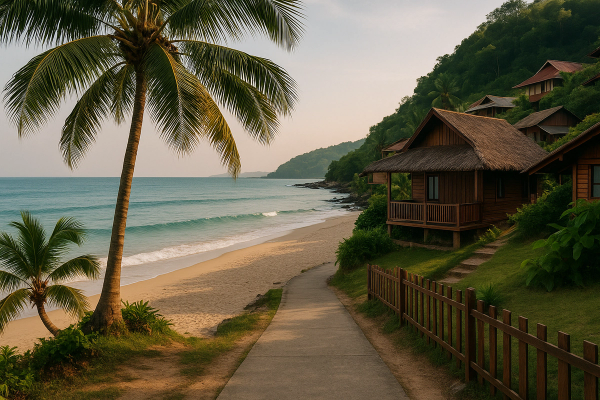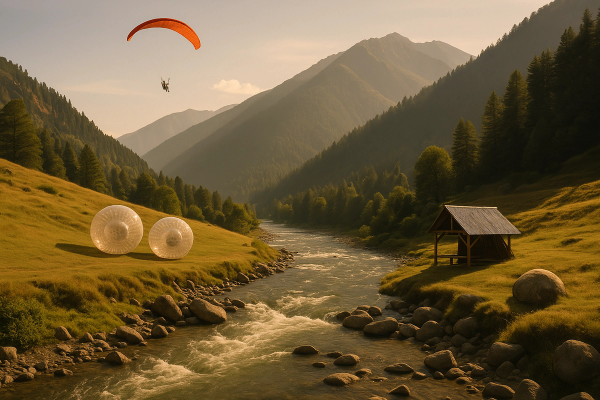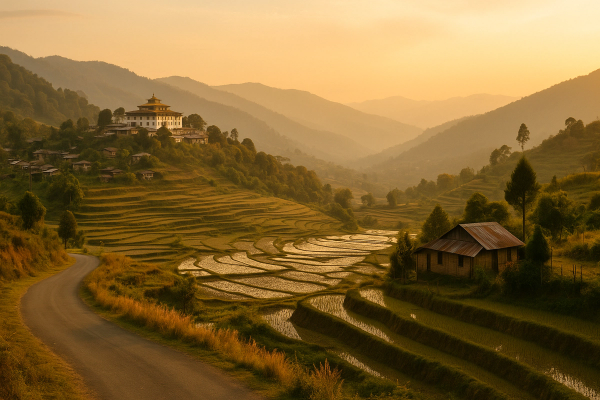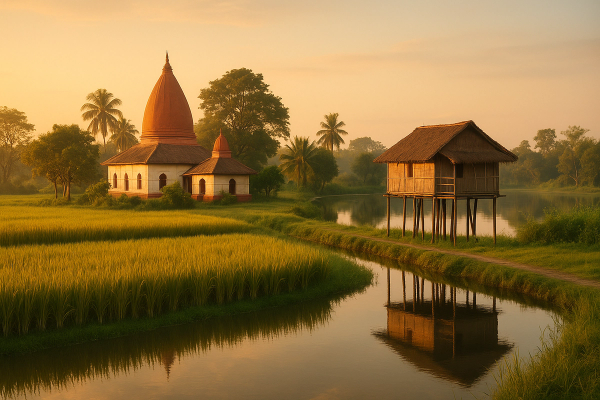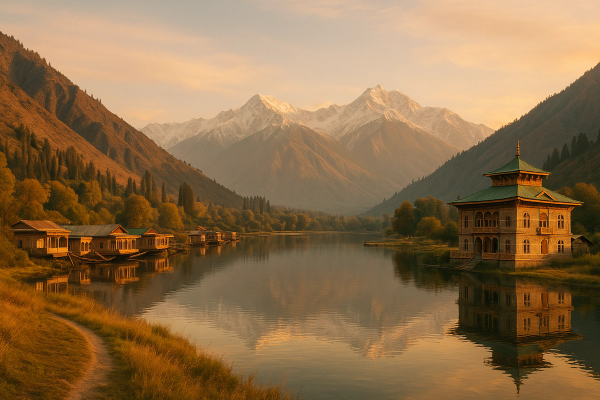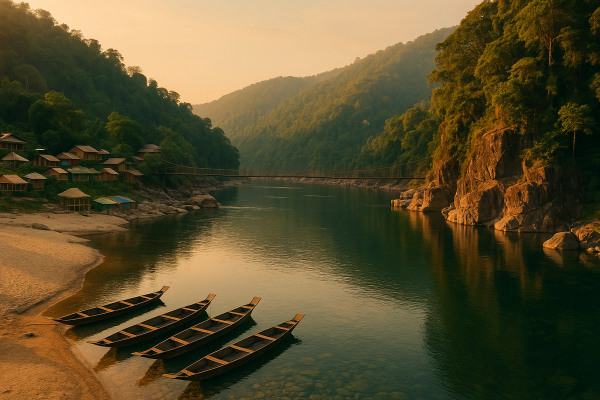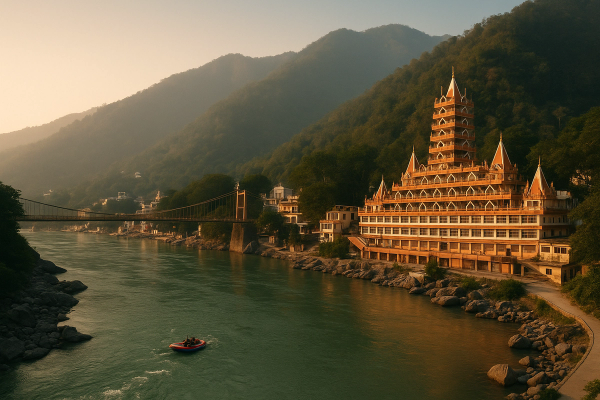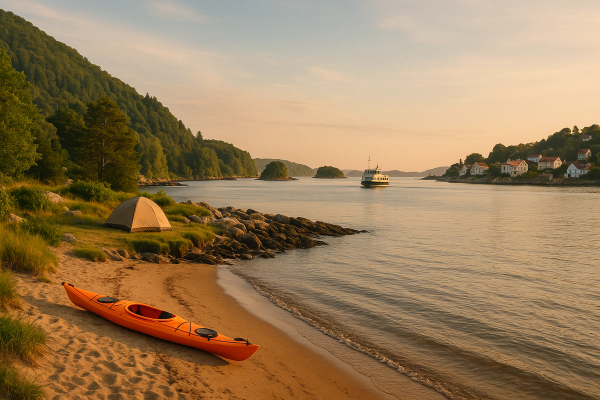Okay, so hey everyone! 👋 Remember that feeling when you stumble onto somewhere really cool, like, before everyone else does? That’s kinda the vibe I’ve been chasing lately. And honestly, 2025 feels like the year for snagging those spots in the US that haven't totally blown up yet. Forget the same old crowded national parks for a sec. I’m talking about places that feel… well, undiscovered. Or at least, way less discovered than they should be.¶
So, I’ve got two totally different but equally mind-blowing destinations on my radar for Undiscovered USA Destinations 2025. We're talking about stunning freshwater sea caves and towering sand dunes in the middle of... well, places you might not expect. Stick around, 'cause I'm gonna spill the deets on the Apostle Islands up in Wisconsin and the Great Sand Dunes down in Colorado. Get ready, your 2025 travel list is about to get a serious upgrade.¶
First Up: The Apostle Islands National Lakeshore, Wisconsin#
Seriously, Wisconsin? Yep. And trust me, it’s not just cheese and Packers. The Apostle Islands National Lakeshore is this string of 21 islands and a little bit of mainland shoreline on Lake Superior. It’s kinda wild, super beautiful, and feels like a mini-adventure just getting there.¶
Island Vibes and Sea Caves#
The big draw here are the sea caves. In the summer, you can kayak into them, which is just… wow. Think red rock cliffs carved out by the lake, cool little hidden spots, and the sound of the water echoing. It’s kinda magical. In the winter, if it gets cold enough and the lake freezes solid (which isn't a guarantee every year, tbh), these turn into ice caves. Icicles hanging everywhere, frozen waterfalls… it’s like stepping into Narnia or something. Not gonna lie, seeing photos of the ice caves is what first put this place on my radar.¶
Beyond the caves, there are old lighthouses on some islands, hiking trails, and just miles and miles of really clear (and cold!) lake water. It feels remote, even though it's accessible.¶
When to Visit Apostle Islands: Chasing the Seasons#
Okay, so timing is pretty key here because the experience changes a lot depending on the season.¶
- Summer (June-August): This is peak season for a reason. The lake is thawed, ferry services to the islands are running, and kayaking is prime time. It's gorgeous, green, and lively. Pro: Everything is accessible, great for kayaking and swimming (if you're brave!). Con: Can get a bit crowded, gotta book ferry and tours ahead, mosquitos can be intense in the evenings.
- Fall (September-October): Honestly, this might be the sweet spot if you're not set on swimming or ice caves. The fall colors are stunning against the blue lake, the crowds thin out significantly, and the weather is often crisp and perfect for hiking. Pro: Fewer people, beautiful scenery, pleasant hiking temps. Con: Ferry service might become limited later in the season, lake activities wind down.
- Winter (December-March): This is the time if the ice caves are your goal. BUT, and this is a big BUT, access depends entirely on the lake freezing safely. You have to check the official National Park Service website constantly for conditions. Pro: Unbelievably beautiful ice formations (if accessible), super unique experience, almost no crowds (except when the ice caves are open, then it's a zoo!). Con: Access is unpredictable and can change daily, it's really cold, limited services.
- Spring (April-May): Kinda the in-between time. The ice is melting, things are waking up. Pro: Very few people, good for watching nature return. Con: Trails can be muddy, ferry service is limited, lake is still freezing cold, conditions are unpredictable.
My personal rec? Late September/early October for the colors and quiet, or take the gamble on a mid-winter trip if the ice caves open. Just be flexible!¶
Getting There and Around the Apostles#
Getting to the Apostle Islands usually means heading towards Bayfield, Wisconsin. It's a cute little harbor town that serves as the gateway.¶
- By Car: This is probably the easiest way to get to Bayfield. It's about a 4-5 hour drive from Minneapolis/St. Paul, or a bit longer from Chicago. The drive is pretty scenic once you get closer to the lake.
- By Air: You could fly into Duluth, Minnesota (DLH), which is about 1.5 hours away, or potentially into Minneapolis (MSP) and then drive. Duluth is closer and a smaller airport, which can be nice.
Quick Tip: Cell service can be spotty up here, especially once you're out on the water or on the islands. Download offline maps before you go!
Getting around is a different story.¶
- Ferry: Apostle Islands Cruises runs ferry tours and shuttles to some of the islands during the warmer months. This is how you get to places like Stockton Island for hiking or Oak Island for views. Book ahead in summer!
- Kayak/Boat Tour: This is essential for seeing the sea caves up close in summer. There are tons of outfitters in Bayfield and nearby Cornucopia that do guided tours. You can also rent kayaks if you're experienced, but Lake Superior is NO JOKE – it's cold, can get rough fast, and navigating around the islands requires skill.
- By Foot/Snowshoe: Once you're on an island or at the mainland sea caves access point (like Meyers Beach), walking is the way to go. In winter, if the ice is safe, you walk across the frozen lake to the ice caves from Meyers Beach.
Where to Stay Near Apostle Islands#
Bayfield is the main hub for accommodation.¶
- In Bayfield: There are charming B&Bs, small hotels, and vacation rentals. It's super convenient for accessing ferries and tours. Prices go up significantly in peak summer.
- Nearby Towns: Consider Ashland (a bit larger town, about 20 mins away) or Washburn for potentially slightly lower prices and more options, though you'll have a short drive to Bayfield.
- Camping: The National Lakeshore has camping spots on some of the islands (wilderness camping, gotta pack everything in and out) and a few drive-up spots on the mainland. This is an awesome way to experience the islands but requires planning and permits.
Personal Experience: We stayed at a cozy B&B just outside of Bayfield. Waking up and having coffee looking out at the lake before heading out for the day was perfection. Plus, the innkeeper gave us awesome tips on local spots!
What to See & Do in the Apostle Islands#
- Kayak the Sea Caves: Seriously, put this #1 for summer. The mainland caves at Meyers Beach are stunning, but a guided tour out to the island caves (like Devil's Island with its arches, or Sand Island) is even better if you have the time and budget. Allow at least half a day, maybe a full day. Costs vary but expect ~$80-150+ for a guided tour.
- Hike on Stockton Island: This island has some cool lagoon trails and is known for its 'singing sands' beach. It's a popular ferry destination for day trips or camping. The trails are relatively easy and let you get a feel for the island's nature.
- Visit a Lighthouse: Several islands have historic lighthouses. Michigan Island and Raspberry Island are often accessible via tours or ferry shuttles and you can sometimes go inside. The views from the lighthouse areas are usually spectacular.
- Walk the Ice Caves (Winter): If they are open and safe! This is a bucket-list experience. The walk from the parking area to the caves at Meyers Beach can be over a mile on potentially uneven ice/snow, so be prepared. Check the NPS website obsessively for conditions before you even think about going in winter. It's free, but parking might have a small fee.
- Explore Bayfield: This town is cute! Browse the little shops, grab an ice cream, or just sit by the harbor and watch the boats.
Avoid the crowds tip: Go early in the morning for kayaking tours, or visit in the shoulder season (late spring/early fall).
Apostle Islands Food Scene: Keep it Simple#
The food scene here is more about casual eats than fine dining. Think fish fries, pasties (a nod to the mining history), and cozy cafes.¶
- Local Fish: Being on Lake Superior, fresh fish is a must-try. Look for whitefish or lake trout, often served fried or baked in local restaurants.
- Casual Restaurants: Bayfield has several spots for a casual meal. The Landmark Restaurant and Morty's Pub are popular options. Expect to pay ~$15-30 for a main dish.
- Picnics: If you're heading out to the islands, pack your own lunch! There are no services on most islands, and enjoying a sandwich with a lake view is the best.
Next Up: Great Sand Dunes National Park & Preserve, Colorado#
Okay, now for something completely different! From the lakes of Wisconsin to the... sand dunes of Colorado? Yep. Great Sand Dunes National Park & Preserve is exactly what it sounds like: the tallest sand dunes in North America, sitting in front of 13,000 and 14,000-foot mountains. It’s like a mini-desert plopped into a mountain range, and it’s seriously cool.¶
Dunes That Touch the Sky (Almost!)#
You see photos, but standing at the base of these things is something else. The Star Dune is the tallest, clocking in at over 750 feet! Climbing them is a workout, for sure, but the views from the top are insane. And the best part? You can sandboard or sandsled down them. It's basically snowboarding/sledding but on sand. So fun, and also kinda hilarious when you wipe out (which you will, lol).¶
There's also a creek, Medano Creek, that flows at the base of the dunes in late spring/early summer, which is wild. People set up chairs in the creek and just chill with the dunes towering above them. It’s a unique beach-in-the-desert situation.¶
When to Visit Great Sand Dunes: Sand, Water, or Snow?#
Like the Apostles, timing matters a lot here.¶
- Late Spring/Early Summer (May-June): This is when Medano Creek is usually flowing at its peak. It's super popular for families wanting to play in the water. Pro: Creek is flowing, great for sandboarding/sledding before the sand gets too hot. Con: Can get very crowded, especially on weekends, afternoon thunderstorms are common.
- Summer (July-August): Hot, hot, hot! The sand can get scorching in the afternoon. Mornings and evenings are best for dune activities. Pro: Long daylight hours, good for stargazing (it's an International Dark Sky Park!). Con: Very hot mid-day, afternoon thunderstorms and lightning are a serious risk, crowds.
- Fall (September-October): My favorite time! The weather is usually fantastic for hiking the dunes, the aspens in the surrounding mountains are changing color, and the crowds thin out. Pro: Pleasant temps for dune activities, beautiful fall scenery, fewer people. Con: Medano Creek is usually dried up by this point.
- Winter (November-April): Yep, you can visit in winter! The dunes often get covered in snow, which is a surreal sight. You can even snowshoe or cross-country ski on the dunes. Pro: Beautiful snowy scenery, almost no crowds, unique experience. Con: Cold temps, potentially difficult road conditions (especially the backcountry road), limited services.
Side note: If you visit in the summer like I did one time, wear gaiters or high-top shoes for the dunes. Sand will get everywhere, lol. And bring WAY more water than you think you need.
Getting There and Around the Dunes#
Great Sand Dunes is located in a pretty remote part of southern Colorado, in the San Luis Valley.¶
- By Car: This is pretty much the only realistic way to get here. It's about a 3.5-4 hour drive from Denver or Colorado Springs. The drive takes you through some beautiful (and sometimes very flat) high desert landscapes.
- By Air: The closest regional airport is in Alamosa (ALS), about 30 miles away, but flights are limited and can be expensive. Most people fly into Denver (DIA) or Colorado Springs (COS) and rent a car.
Heads up: The park entrance is straightforward, but if you want to explore the backcountry (like driving the Medano Pass Primitive Road), you need a high-clearance 4x4 vehicle. Seriously, don't try it in a regular car.
Getting around the park is mostly on foot once you're at the dune field. There's a main parking lot and the visitor center is right there. The Medano Pass Primitive Road lets you access different parts of the park (and primitive campsites) if you have the right vehicle.¶
Where to Stay Near Great Sand Dunes#
Accommodation options are a bit more limited right near the park.¶
- Inside the Park: There's a campground (Pinon Flats Campground) that books up way in advance. There are also 21 primitive backcountry campsites along the Medano Pass Road (4x4 needed!) and designated wilderness camping in the dunes (requires a free permit). Camping is awesome here because the stargazing is incredible.
- Near the Entrance: The Great Sand Dunes Lodge is the closest hotel, just outside the park entrance. It's convenient but can be pricey.
- In Alamosa: About 30 miles away, Alamosa has more hotel and motel options across different price points. It's not super close, but it's the most reliable town for lodging and supplies.
- Vacation Rentals: You might find some cabins or rentals scattered in the surrounding areas, but options are sparse.
Booking Tip: If you want to camp in the park campground during peak season (May-Sept), you NEED to reserve a spot months in advance on Recreation.gov. Like, the day they become available.
What to See & Do at Great Sand Dunes#
- Sandboard or Sandsled: You can rent boards and sleds just outside the park entrance at places like Kristi Mountain Sports in Alamosa or the small shop near the park entrance. This is an absolute must-do! Expect rentals to be around $20-30 for the day. It takes some effort to get up the dunes with the board, btw!
- Hike the Dunes: Just wander! There are no marked trails on the dune field itself, you just pick a dune and start climbing. Aim for High Dune for awesome views without going all the way to Star Dune. For a real challenge, hike to Star Dune. Do this in the morning or late afternoon to avoid the heat.
- Play in Medano Creek: If the water is flowing (usually May-June), this is a super unique experience. The water is shallow and gentle, perfect for wading or floating. It creates this cool 'surge flow' effect.
- Go Stargazing: This park is a designated International Dark Sky Park, and the stars are absolutely mind-blowing out here with no light pollution. Stay up late (or get up early!) to see the Milky Way.
- Drive the Medano Pass Primitive Road: If you have a high-clearance 4x4 and like a rugged adventure, this road takes you through varied terrain (sand, forest, stream crossings) and offers access to different parts of the park and hiking trails in the mountains. Check conditions first!
Pro Tip: Climb the dunes barefoot in the cooler parts of the day – it feels amazing! But check the sand temp first; it gets HOT.
Great Sand Dunes Food Scene: Pack Your Own#
Okay, so the food scene at the park is basically non-existent beyond snacks at the visitor center. You'll need to plan ahead.¶
- Pack a Cooler: Seriously, pack lunches, snacks, and tons of water. This is key for spending a full day in the park.
- Grill at the Campground: If you're camping, cooking your own meals is the way to go.
- Alamosa Options: Your best bet for restaurants is in Alamosa. You'll find typical fast food, a few diners, and some local spots. San Luis Valley Brewing Company is a decent option for a casual meal and local beer.
Practical Tips for Visiting These Undiscovered Gems in 2025#
Budget Breakdown (Rough Estimates per Person, per Day)#
These are just ballparks, obviously, and depend heavily on your travel style and how far in advance you book. Prices can swing a lot, especially in peak season.¶
| Expense | Apostle Islands (Mid-Range) | Great Sand Dunes (Mid-Range) |
|---|---|---|
| Accommodation | $100-$200 per night | $80-$180 per night (more if staying right at park entrance) |
| Meals | $40-$70 per day (less if picnicking) | $30-$60 per day (less if cooking/picnicking) |
| Activities/Entry Fees | $50-$100 (ferry/kayak tour) | $15-$30 (park entry pass, sandboard rental) |
| Misc (Gas, snacks) | $20-$40 | $20-$40 |
| Daily Total | ~$210-$410 | ~$145-$350 |
Money Saver: Camping at both parks significantly cuts down on accommodation costs if you're into that!
What to Pack#
- Layers, layers, layers: Weather can change fast in both locations, especially near the lake or in the mountains. Bring options.
- Good walking/hiking shoes: Essential for exploring islands or climbing dunes.
- Sunscreen, hat, sunglasses: The sun is intense at both spots, especially with reflections off water/sand/snow.
- Insect repellent: Non-negotiable for Apostle Islands in warmer months.
- Water bottle: Stay hydrated! Especially at the dunes where it's dry.
- Headlamp/flashlight: Crucial for camping or just walking around after dark (hello, stargazing!).
- For Sand Dunes: Gaiters or high socks to keep sand out of your shoes, maybe an old bandana for wind/sand.
- For Apostle Islands: Waterproof bag for kayaking, quick-dry clothing.
Safety & Respect#
- Wildlife: Be aware of bears (black bears mostly) in both areas, especially if camping or hiking in less populated spots. Store food properly.
- Weather: Afternoon thunderstorms with lightning are common in the mountains (Great Sand Dunes) in summer. Get off the dunes/exposed areas if you hear thunder. Lake Superior weather can change rapidly – pay attention to forecasts if on the water.
- Sand Dunes Specifics: The sand gets incredibly hot in summer afternoons. The dunes are steep – going down can be tricky, watch your step. Stay hydrated – altitude + sun + exertion is a combo.
- Leave No Trace: Pack out everything you pack in. Stay on marked trails where they exist. Don't feed wildlife. Respect the natural environment – these places are special.
Seriously, check the National Park Service websites for both locations before you go. They have the most up-to-date info on conditions, closures, and safety alerts.
Suggested (Flexible!) Itineraries#
Apostle Islands Weekend Splash (3 Days)#
- Day 1: Arrive in Bayfield, check into your accommodation. Explore the town, walk along the harbor, maybe grab dinner. Sunset views over the lake are a must.
- Day 2: Full day sea cave adventure! Book a guided kayak tour for the morning or early afternoon. Spend the rest of the day recovering/exploring Meyers Beach or relaxing in Bayfield.
- Day 3: Take a ferry shuttle to one of the islands like Stockton or Raspberry Island. Do a short hike or visit a lighthouse. Head back in the afternoon and depart.
Great Sand Dunes Quick Hit (2 Days)#
- Day 1: Arrive at Great Sand Dunes NP. Head straight to the visitor center, then rent sandboards/sleds. Spend the late afternoon/early evening playing on the main dune field. Watch the sunset from the dunes (epic!). Camp or check into lodging in Alamosa.
- Day 2: Morning hike up High Dune for sunrise (worth the early alarm, I promise!). If the creek is flowing (May/June), spend some time wading there. Head back to Alamosa for lunch before driving on to your next destination.
Timing Tip: For the dunes, morning is always better for hiking and sand play before the heat kicks in. For the Apostles, mid-day is fine for ferries, but sea cave tours are often best earlier.
Traveling Responsibly#
Okay, real talk for a sec. These places are incredible, and keeping them that way is up to us.¶
- Leave No Trace: This applies everywhere, but especially in natural areas. Pack out trash, stay on designated paths (where they exist), and minimize your impact.
- Respect Wildlife: Keep a safe distance, and never, ever feed the animals.
- Apostle Islands Specific: Be mindful of the lake. Don't leave anything behind on the islands or beaches. If kayaking, be aware of sensitive areas.
- Great Sand Dunes Specific: Stay off fragile vegetated areas around the dunes. They help keep the ecosystem stable. Don't leave anything on the dunes – litter impacts the sand movement.
- Support Local: Try to support local businesses in Bayfield or Alamosa when you're buying food, souvenirs, or booking tours. Your dollars make a difference in these smaller communities.
Final Thoughts: Why 2025 is the Year#
Honestly? These two spots, the Apostle Islands and Great Sand Dunes, blew me away in totally different ways. The peace and wildness of the Great Lakes islands contrasted with the surreal, almost alien landscape of the Colorado dunes. They both offer something unique and feel like you're stepping a little bit off the beaten path.¶
I mean, kayaking into a sea cave? Sliding down a giant sand dune? These are experiences you don't forget. And while they aren't completely unknown, compared to places like Yellowstone or the Grand Canyon, they still feel wonderfully accessible and, dare I say, a bit 'undiscovered'.¶
So, yeah. If you're looking for adventure, unique landscapes, and a break from the usual tourist traps in 2025, seriously consider heading to Wisconsin's coast or Colorado's high desert. You won't regret it.¶
Have you been to either of these spots? What did you think? Share your favorite part in the comments! Planning a trip to an undiscovered gem? Save this guide for later or check out our other travel resources! Safe travels!¶



